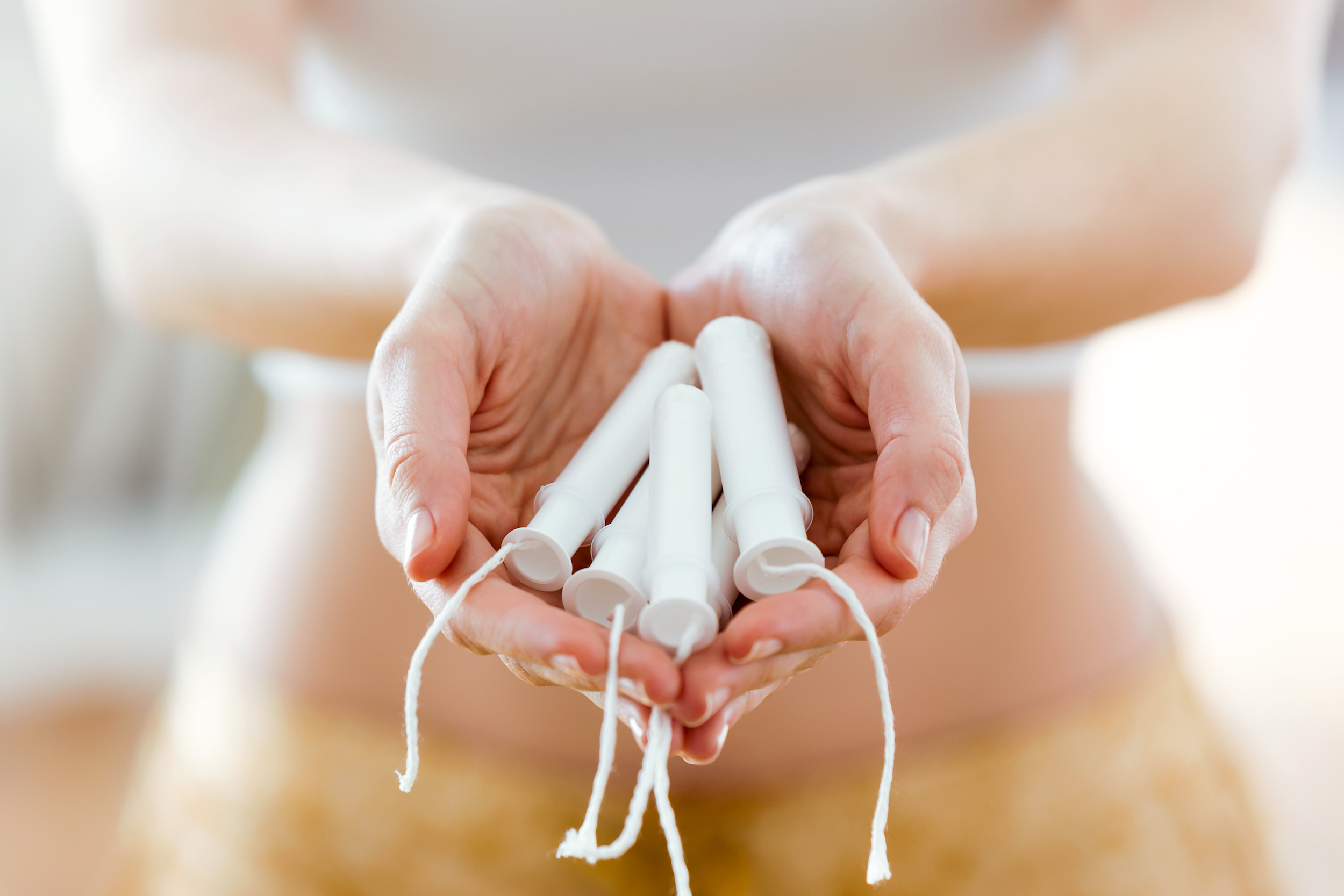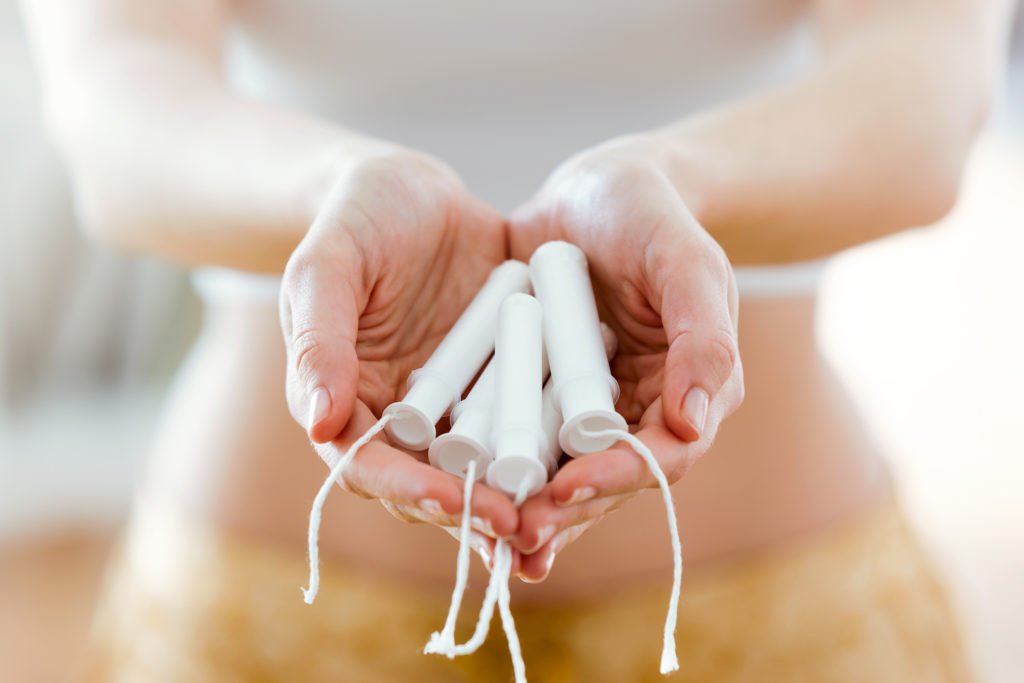
Inside this post: Unsafe toxins found in feminine care products like tampons and pads. Toxic tampons. Safe alternatives to ditch chemicals from entering your bloodstream once a month.
This post may contain affiliate links. You can see my disclosure policy here.
The Toxins in Your Tampons & Pads Are Harming You
Listen up fellow females and parents raising daughters, it’s time we had a chat about periods.
Women’s personal and feminine care products are some of the most toxic out there, and since you’ve probably been using feminine products since you were 13, 14, 15, maybe 16… that’s a lot of years of use.
The thing is… do you even know what’s in the products you’re using?
Women’s Voices for the Earth November 2013 Chem Fatale report (PDF) found toxic chemicals commonly used in feminine care products like pads and tampons.
Conventional feminine products, contain a toxic blend of chlorine-bleached pulp, polypropylene, polyacrylates and plastic. Tampons are manufactured from rayon fibers, viscose and other undisclosed ingredients (because manufacturers aren’t required to tell us.)
The FDA doesn’t require tampon makers to be totally transparent with their production process and product contents. Manufacturers don’t have to reveal all of the ingredients in the product.
Why?
As WVE notes in Chem Fatale, a tampon is classified as a Class II Medical Device. That means, the labels on tampons don’t have to list all their ingredients like you’d see on a soup can or box of crackers. That doesn’t mean a manufacture won’t list ingredients on their product, but what you see, is often not all you get.
Don’t we deserve to have full transparency of what we’re putting in our bodies and using?
And it gets worse.
Chemicals used in feminine care products are virtually unregulated by governmental agencies in the United States.
Products such as feminine washes, wipes, and sprays are classified as “cosmetics” and fall under the regulation of the FDA.
According to the law, cosmetics, including feminine care products, sold in the United States must be free of poisonous or deleterious substances that might harm users under conditions of normal use.
However, the FDA admits that it does not assess or pre-approve products before they are marketed or require cosmetic companies to share safety information with the FDA.

Toxic Chemicals Found in Feminine Care Products:
The list put together in the November 2013 Chem Fatale report (PDF) lists ingredients found in feminine care products like pesticides, parabens, “fragrance,” dioxins, and benzethonium chloride.
Most feminine products get their stark white color from a chlorine bleaching process that results in the production of dioxin, an organochlorine the EPA considers a known carcinogen.
You may be familiar with the dioxins or dioxin-like compounds: DDT, PCB, and Agent Orange.
Dioxin is the most prevalent ingredient found in feminine care products and is linked to breast cancer, immune system suppression, endometriosis, pelvic inflammatory disease, reduced fertility and changes in hormones.
Dioxin bioaccumulates in the body and can remain in the body for up to 30 years after first exposure.
Most importantly, these chemicals are into contact with some of the most absorbent tissues in your body; essentially, taking an express route into your bloodstream.
Here’s a look behind the curtain of what feminine products on the shelves right now may include according to the Chem Fatale report:
Tampons:
Hazardous ingredients may include dioxins and furans (from the chlorine bleaching process), pesticide residues and unknown fragrance chemicals. Exposure concerns: cancer, reproductive harm, endocrine disruption, and allergic rash.
Tampons are the most popular feminine care products are tampons and menstrual pads, used by 70-85% of women.
Pads:
Hazardous ingredients may include dioxins and furans, pesticide residues, unknown fragrance chemicals, and adhesive chemicals such as methyldibromo glutaronitrile. Exposure concerns: cancer, reproductive harm, and endocrine disruption and the study link pad use to allergic rash.
Feminine Wipes:
Hazardous ingredients may include methylchloroisothiazolinone, methylisothiazolinone, parabens, quaternium-15, dmdm Hydantoin and unknown fragrance chemicals. Exposure concerns: cancer and endocrine disruption. studies link wipe use to allergic rash.
Feminine Wash:
Hazardous ingredients may include unknown fragrance chemicals, parabens, methylchloroisothiazolinone, methylisothiazolinone, dmdm Hydantoin, d&c red no.33, ext d&c violet #2, and fd&c yellow #5.Exposure concerns: endocrine disruption, allergic rash, and asthma.
Douche:
Hazardous ingredients may include unknown fragrance chemicals and the spermicide octoxynol-9. studies link douche use to bacterial vaginosis, pelvic inflammatory disease, cervical cancer, low-birth weight, preterm birth, Hiv transmission, sexually transmitted diseases, ectopic pregnancy, chronic yeast infections, and infertility.
Feminine deodorant (sprays , powders and suppositories):
Hazardous ingredients may include unknown fragrance chemicals, parabens, and benzethonium chloride.Exposure concerns: reproductive harm, endocrine disruption and allergic rash.
Feminine anti-itch creams:
Hazardous ingredients may include unknown fragrance chemicals, parabens, methylisothiazolinone and an active ingredient, benzocaine, a mild anesthetic. Exposure concerns: endocrine disruption, allergic rash, and unresolved itch.
The Secret Toxic Chemicals Found in “Fragrance”
Many feminine care products, as well as body care, are heavily fragranced, yet the companies only disclose the generic term “fragrance” as an ingredient, even though many chemicals make up a fragrance.
The international fragrance association’s (ifra) master list of chemicals used in fragrance includes:
- carcinogens like p-dichlorobenzene and styrene oxide;
- endocrine disruptors like galaxolide and tonalide (synthetic musks);
- reproductive toxicants like diethyl phthalate (DEP) and di-isononyl phthalate (DINP);
- Problematic disinfectants like Triclosan and ammonium quaternary compounds; and
- numerous allergens
The rub?
IFRA’s list doesn’t disclose which companies are using these chemicals or which products they’re in. Legally, companies are allowed to keep “fragrance” ingredients a beauty trade secret from consumers.
Ugh. I know, I feel the same way too.

Safe & Organic Feminine Care Alternatives
CORA TAMPONS & PADS
I really like the Cora brand and am confident in their clean product. They are 100% CERTIFIED ORGANIC COTTON. Biodegradable organic cotton. Pesticide-free. Bleach-free. Fragrance-free. Toxin-free. Non GMO. Here are the Non-applicator regular and super pack (I don’t like the plastic applicator option) and organic cotton overnight pads (but I haven’t personally tried this, although the reviews are good.)
RAEL TAMPONS & PADS
Rael tampons are 100% GOTS CERTIFIED ORGANIC COTTON CORE which mean they don’t use any toxic materials, pesticides or fertilizers. It comes with a cardboard applicator and is 100% hypoallergenic. No harsh chemicals, dyes, fibers, fragrances, rayon, viscose or synthetics. The Rael pads are made from chlorine-free natural wood pulp and are also 100% organic.
They also have pantyliners which are OCS, USDA certified, and non-GMO cotton from Texas. The cotton is safely grown without the usage of toxic pesticides and synthetic chemicals.
L. Organic
These L. Organic tampons are made with GOTS Certified Organic Hypoallergenic Cotton that is free of synthetic pesticides, chlorine bleaching, fragrances, rayon, chlorine bleach and dyes. Here are the organic and chlorine free pads for daytime and overnight use. You can find these at Target and depending on what they have in stock, I usually go between L. Organic and Cora brand tampons – both work well.
She Thinx
I know menstrual underwear are also popular with a lot of women. Personally, I haven’t ever used them but it could be a good option for you. There are three styles of underwear that hold up to 2 tampons’ worth.
Menstrual Cups are Also a Popular and Safe Silicon Option
Diva or Luna are safe and non-toxic options are made of 100% medical grade silicone, are soft, comfortable to wear and provide excellent leakage protection.
FREEBIE ALERT
To better understand exactly what harsh toxins are lurking in your home and why they should have no place around your family – Download Your Free Starter Guide to Environmental Toxins Hiding in Your Home